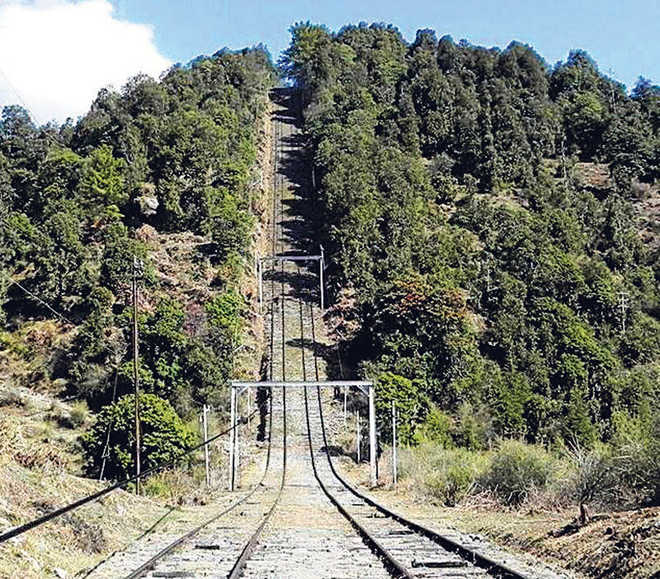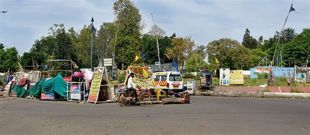
Jogindernagar Tramway. The experience in Hong Kong, San Francisco and Rio de Janeiro in Brazil is nothing in comparison to Jogindernagar Tramway. The trolleys running in Jogindernagar were procured in 1930 during the construction of Shanan Hydroelectric Power Project. Photos by writer
Dr Chiranjit Parmar
A few days ago, I happened to read an article about the plight of Jogindernagar-Barot tramway. I also travelled in the trolleys plying on this route about 7-8 years ago. This tramway is really in a much neglected state.
The trolleys running there were procured in 1930 during the construction of Shanan Hydroelectric Power Project. These are still in operation. But sitting and travelling in these is no different from travelling in a bullock cart. There is a small cabin in front with a wooden bench which can accommodate four persons. In the back, there is an open space for carrying material and passengers if required.
The trolleys are hooked to a metallic rope. Two trolleys are hooked on each end. This rope is moved by an electric motor and trolleys start going up and down on the railway line. This line gets bifurcated for a small distance in the middle to enable trolleys to cross. It is very interesting to watch the two trolleys cross each other, one going upwards and other going downwards.
There is no engine, no steering wheel, no gears or brakes. But of course, a driver is there. This driver has a long copper stick. Two wires fixed on poles like old time telephone lines, run all along the way. When the driver touches these lines with his copper rod one time, a bell rings once at the control room and the operator switches the motor off to stop the tram. To start it again, the driver touches the wires two times and the bell at the control tower rings twice, meaning the trolley should now move. The entire system, though working on 90-year-old technology, is very interesting and perfect.
Trolley starts from Jogindar Nagar. There are four stations up to Barot. One has to shift to another trolley at the second station, after which you reach Winch Camp, which is at the top of a hill at 9,000 ft. From there, one has to walk about 2 km to reach the third station called Head Gear. There is also a railway line connecting both stations, but is defunct at present. From Head Gear, you start going down and again change trolley at Kaphyadu to reach Barot. Between Head Gear and Kaphyadu, the slope at one point is 75 degrees. This stretch is called Khoonee Ghatee.
This entire journey is very exciting, enjoyable and I would say an unforgettable experience. There are steep climbs on the way. One passes through jungles, too! If this tramway is opened for tourists and promoted well, it will surely be a big hit. Tourists won’t hesitate to pay even Rs 1,000 for a round-trip ride to Barot from Jogindernagar.
During my travels, I have seen such trolleys only at three places and everywhere these were very popular among tourists. The first was at Hong Kong, second at San Francisco, and third at Rio de Janeiro in Brazil. In Hong Kong, it runs on a straight climb to the hill called Victoria Hill. One gets a beautiful view of Hong Kong city and the harbour from there. People spend time, have something in restaurants and come back. But this experience is nothing in comparison to Jogindernagar Tramway.
The San Francisco trolley is called “cable car”. These go over the small hill from the Market Street and descend to the other side at Fisherman’s Wharf, which they have developed as an amusement area for tourists. There are many shops there that sell seafood and other eatables. These cable cars are a major attraction of San Francisco and are also promoted as a logo for that city.
The trolley that takes people to the famous statue of Christ the Redeemer at one of the hill tops around Rio de Janeiro is also called cable car. Its route is a bit longer. It also passes through a jungle. From the top, one can get a breathtaking view of Rio de Janeiro city and its beaches. As this statue is now included among the seven wonders of the world (modern), so thousands of people visit it every day. Though this drive is little longer than those at Hong Kong and San Francisco, yet travel on this route is still not as exciting as that on Jogindernagar-Barot route.
Our government must exploit the Jogindernagar-Barot tramway for tourism purposes. It will not require much effort. Infrastructure already exists. Only new cable cars are required. If done, it will be a great tourist attraction. A beginning can be made even with existing trolleys by sprucing these a bit.
(The writer is a senior fruit scientist based in Mandi)



























